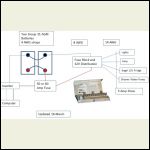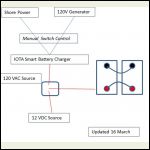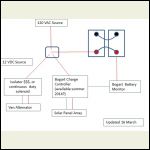|
| Author |
Message |
analogphotog
Member
|
# Posted: 21 Oct 2015 11:17pm
Reply
I have read through many of the threads here, both old and new, and I may be more confused then when I started maybe!
I am working on my 12x32 cabin and soon I will need to install my power.
My basic plan is to run my lights off 12V DC and all my other electrical needs off of the A/C Inverter that is tied to a battery bank and solar panels. Those A/C items will be a small fridge, fan, toaster oven, etc.
For the lights, I was planning on using all LED 12V DC lights because of the lower power consumption and my good experience with them when camping off the grid in my van. My question involves the type and gauge of wire to run to the lights. Based on my 12x32 cabin, I expect to have lights in various places throughout the cabin. Should I just run regular house wiring 12 or 14 gauge? Or do something else?
Thanks in advance for your help.
|
|
MtnDon
Member
|
# Posted: 22 Oct 2015 01:21am
Reply
IMO, if you plan on having some devices, like a 120 VAC refrigerator, toaster oven, etc., then it does not make a lot of sense to also run 12 VDCwiring for some lights. Buy a good quality pure sine wave inverter and run AC devices. The exception to that may be to have a couple of DC lights for when something happens to the inverter. $hit happens and sometimes happens in the dark.
And IMO, your cabin is big enough to forgo a 12 VDC battery system and go for 24 VDC.
|
|
bldginsp
Member
|
# Posted: 22 Oct 2015 08:32am
Reply
If you choose to use a separate DC system for the lights, yes, you can use regular 14 or 12 gauge romex for the wiring. But remember that the limitation on any wiring is the amperage you can run through it. If you do a little math with:
Volts x amps = watts
you'll quickly see that you can't push much wattage through a 14 gauge wire at 12 volts- only about 200. That's fine if it's only lighting, those LED lights are very low wattage.
You'll need a separate subpanel with breakers rated for DC.
But like MtDon I'm wondering if it's worth installing two separate systems, if you are going to have an inverter to begin with.
|
|
analogphotog
Member
|
# Posted: 22 Oct 2015 04:10pm
Reply
Hi Thanks... good points. And, this is exactly why I am writing to the group here. Sounds like I should just wire the entire cabin with 12 ga. romex and use the inverter for everything and keep some dc lights as backup that I could use in case of an outage from the A/C system.
|
|
bldginsp
Member
|
# Posted: 22 Oct 2015 09:07pm
Reply
14 gauge is more than enough for lighting circuits if you are using LEDs. No need to use 12. You could put over 300 5 watt LED lights on one #14 circuit at 120 volts, 35 of them on the #14 wire on 12 volt. LED makes lighting so easy. Don't instal more wire than you need.
|
|
analogphotog
Member
|
# Posted: 22 Oct 2015 09:27pm
Reply
Thanks for the advice.
|
|
DaveBell
Moderator
|
# Posted: 23 Oct 2015 02:40am - Edited by: DaveBell
Reply
Here is a multi-source design I created a year ago for my home made RV. May be of some use.
These drawings are rough.
The first pic is wire size and distribution.
The second pic there are two manual switches, one to isolate the 120V shore power source from the 120V generator source , the other switch blue square to isolate 12V from 120V. And this slide shows 120V detail.
The third pic is 12V detail.
There may be info missing that other folks may be able to help with. This is a first draft.
12Volt_Pic1.jpg
| 
12Volt_Pic2.jpg
| 
12Volt_Pic3.jpg
|  |
|
|
|

